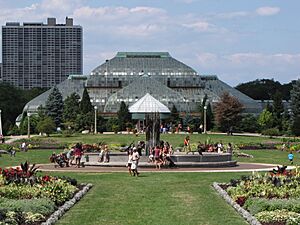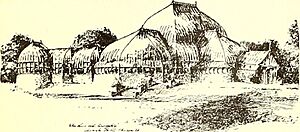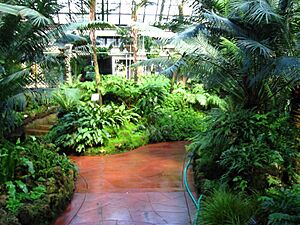Lincoln Park Conservatory facts for kids

Lincoln Park Conservatory and the Great Garden
|
|
| Established | 1877; in present location since 1893 |
|---|---|
| Location | 2391 North Stockton Drive, Chicago, Illinois, USA 60614 |
| Public transit access | |
The Lincoln Park Conservatory is a special kind of greenhouse and plant garden in Lincoln Park in Chicago, Illinois. It covers about 3 acres (1.2 hectares). You can find it at 2391 North Stockton Drive. It's near Fullerton Avenue and Lake Shore Drive.
This beautiful building is a Victorian-era glass house. It was built in the late 1800s. Inside, there are four rooms filled with amazing plants from all over the world. You can see rare orchids, like the Moth orchid, in the Orchid room.
Right in front of the Conservatory is a formal garden. It's one of Chicago's oldest public gardens. It was first designed and planted in the late 1870s. This garden has been home to many sculptures over the years. The garden is usually planted between May and June. The best time to visit is from July to August. The plants stay beautiful until mid-October.
Contents
History of the Conservatory
Conservatories were once places connected to hospitals. They grew plants for medicine and research. In the early 1800s, new ways of building with iron and glass became popular. This led to many conservatories being built in big cities. Chicago was growing very fast and becoming crowded.
People started to worry about how factories were affecting nature. So, collecting and studying plants became very popular. City leaders decided to build a bigger, better conservatory. It would replace a small greenhouse from the 1870s.
Architects Joseph Lyman Silsbee and M.E. Bell designed this new glass conservatory. It was called "a paradise under glass." At first, water plants were kept in a heated pond outside. Later, they were moved inside the conservatory. The exotic plants were so popular that in 1897, the Egyptian government even asked for water lily seeds!
Who Designed It?
The Lincoln Park Conservatory was built between 1890 and 1895. The Lincoln Park Commission had already set up a greenhouse in 1877. They also planted the formal garden next to it in 1880. But the small greenhouse wasn't big enough for all the plants. People loved learning about horticulture, which is the art of growing plants.
So, larger conservatories with many different plants and rooms became popular. A famous architect named Joseph Lyman Silsbee designed the Victorian-style conservatory. He worked with another Chicago architect, Mifflin E. Bell. They created a glass building that would hold "a luxuriant tropical growth." Silsbee gave the conservatory an exotic look. He used special curved arches called ogee arches.
Exploring the Halls
The conservatory has an entrance area, four main display halls, and fifteen smaller rooms for growing plants.
Palm House
The entrance area and the Palm House opened in 1892. The Palm House is home to giant palm trees and rubber trees. One rubber tree, planted in 1891, is 50 feet (15 meters) tall! This large room has over twelve different types of palms. Some unusual ones are Dwarf Sugar and Fiji Fan palms. You might recognize the pygmy date palm and the coconut palm. This house also grows plants that give us food. These include banana plants, grapefruit trees, orange trees, and even a coffee tree. You can also see a sculpture called Garden Figure by Frederick Hibbard here.
Fern Room
The Fern Room, also called the Fernery, opened in 1895. It is a bit lower than the other rooms. It has plants that grow on the forest floor. There's a huge collection of ferns. It also has cycads, which are very old plants. Fossils of cycads show they existed at least 250 million years ago! These plants are more like pine trees than palm trees.
Orchid Room
The Tropical Room was once called the stove house. It opened in 1895. It used to have tropical plants hanging from bark-covered walls. Now, it's called the Orchid Room. It has about 25,000 different kinds of orchids. This room also has hundreds of bromeliads and some tropical carnivorous plants. Orchids and bromeliads get their water from the air's humidity.
Display House
The Display House, or Show House, is used for special flower exhibits that change with the seasons. The "Spring Flower Show" usually runs from late January to mid-May. After that, the "Tropical Summer Show" takes over from early June to late September. Finally, the "Winter Flow and Train Show" starts in late November and ends in early January.
Gardens Around the Conservatory
The conservatory and its outdoor gardens have always been connected. Just south of the building is the Great Garden. This large formal garden is one of Chicago's oldest public gardens. It was created 20 years before the current conservatory. In the garden, you'll find twelve beds of colorful summer flowers. These surround a sculpture called Storks at Play. It's also known as the Eli Bates Fountain. This fountain was installed in 1886-1887.
At the south end of the garden is the Schiller Monument. It's a copy of a statue of the German poet Friedrich Schiller. It was made in Germany and put up in 1886. To the west, you'll find the William Shakespeare Monument. It sits in an old English garden. This statue was put in place in 1894.
Conifer Garden
Outside, along the west side and front of the Conservatory, you'll see various conifers. Conifers are trees and shrubs that have needle-like leaves and grow cones. Most of these conifers stay green all year round.
Changes Over Time
The Lincoln Park Conservatory had some big changes in 1925. The original front entrance and terrace were removed. The old pointed roof of the entryway was replaced with the bell-shaped roof you see today. A new, larger lobby was also built. The front of the conservatory was changed again in 1954. This was to add public restrooms and create a stronger entrance area.
See also
 In Spanish: Invernadero de Lincoln Park para niños
In Spanish: Invernadero de Lincoln Park para niños





